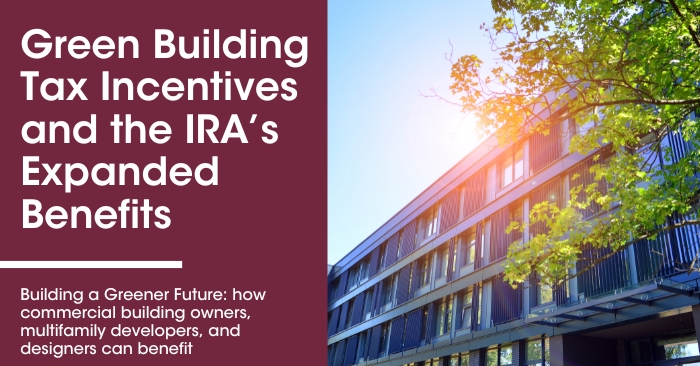Green Building Tax Incentives and the IRA’s Expanded Benefits
Building a Greener Future: how commercial building owners, multifamily developers, and designers can benefit
With a goal of substantially reducing greenhouse gas emissions by 2030, the federal government has expanded a series of Green Building Tax Incentives. These initiatives represent a crucial step in the larger effort to reward commercial and residential developers for constructing buildings that are highly energy-efficient and improve indoor air quality and comfort.
With various Green Building Tax Incentives, like the 179D Energy-Efficient Commercial Building Tax Deduction and 45L Tax Credit, already put in place, building owners, developers, and designers can be rewarded for being involved in constructing buildings that utilize energy more efficiently.
Impacts of Green Building Tax Incentives
Green Building Tax Incentives are made up of a diverse spectrum of tax benefits that encompass more than just improving the energy efficiency in buildings, ranging from tax credits for multifamily developers to tax deductions for architects and other designers. These initiatives were specifically put in place by the government to encourage more participation in green construction tax programs and create a future where there’s less demand for power.
How the Inflation Reduction Act Expanded the Benefits of Green Building Tax Incentives
The roots of government-driven green building tax programs trace back to the early 2000s, when the Energy Policy Act was launched in 2005, resulting from policymakers recognizing the urgent need to incentivize energy-efficient construction practices. While tax policies to drive greener building practices were already in place, it was the signing of the Inflation Reduction Act (IRA) in 2022 that cemented the government’s commitment to make constructing energy efficient buildings even more economically attractive for commercial building owners, multifamily developers, and designers.
With the IRA taking effect on August 16, 2022, the benefits of flagship programs, such as the 179D Tax Deduction and the 45L Tax Credit, underwent a significant expansion that made these incentives more beneficial. These programs, which had already been instrumental in encouraging the adaptation of energy-efficient building practices, now offered an even more compelling proposition. Eligible projects stood to gain more participants, as the IRA allowed for higher monetary claims, making energy efficiency a financially rewarding choice for potential candidates.
179D Energy-Efficient Commercial Building Tax Deduction
The staple behind tax incentives for commercial buildings, the 179D Tax Deduction now allows eligible parties to claim enhanced deductions for implementing energy-saving technologies and designs in commercial and tax-exempt buildings. This not only translates into immediate cost savings but also promises long-term operational efficiency and an overall reduction in air pollution.
45L Tax Credit
Starting in 2023, the 45L Tax Credit has been expanded to promise greater financial benefits of up to $5,000 per unit for developers of energy-efficient homes. This means that in the residential sector developers who incorporate green building practices into their design at preconstruction are not only contributing to a greener future but also benefiting from increased financial incentives.
The IRA reshaped the landscape of construction by amplifying the economic rewards for energy efficiency. By doing so, it sent a clear message that green building is not just an ecological imperative. It also reaps financial benefits. As the movement for Green Building Tax Incentives continues to gain momentum, the IRA ensures building owners, developers, and designers have every reason to prioritize energy–efficient, renewable–ready, and eco-friendly construction that improves indoor air quality and advances the goal of a greener, more sustainable environment.


